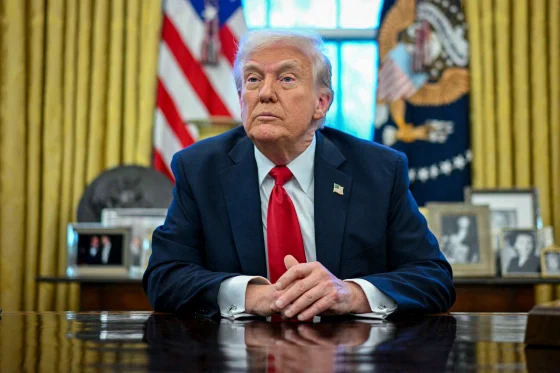With increasing losses in lower federal courts, President Donald Trump has reverted to a strategy he utilized with considerable success at the Supreme Court during his first term.
In the past week alone, and six times since Trump assumed office just over two months ago, the Justice Department has urged the conservative-majority high court to intervene in cases significantly earlier than customary.
This emergency appeal strategy, known as shadow docket, is being employed by the administration amidst over 130 lawsuits challenging the Republican president’s numerous executive orders. Many of these lawsuits have emerged from liberal-leaning regions, as the court system becomes a pivotal battleground against his policies.
According to the Justice Department’s filing on Friday, federal judges have ruled against the administration more than 40 times, issuing temporary restraining orders and preliminary injunctions. These issues encompass changes in birthright citizenship, federal spending, transgender rights, and deportations under a rarely invoked 18th-century law.
The administration is increasingly petitioning the Supreme Court, which Trump influenced by appointing three justices, not just for favorable rulings but also to convey a message to federal judges, whom Trump and his supporters assert are overstepping their bounds.
“Only this Court can stop rule-by-TRO from further undermining the separation of powers — the sooner, the better,” acting Solicitor General Sarah Harris stated on Friday concerning the deportations case, referring to the temporary restraining orders.
Stephen Vladeck, a law professor at Georgetown University and author of “The Shadow Docket,” noted on the Substack platform that “these cases, particularly together, highlight the looming dilemma — just how much will the Supreme Court push back against Trump?”
During the previous Trump administration, the Justice Department submitted emergency appeals to the Supreme Court 41 times and achieved all or part of its desired outcomes in 28 cases, as Vladeck discovered.
In contrast, the Obama and George W. Bush administrations sought emergency relief from the court merely in eight instances over a span of 16 years.
Typically, Supreme Court cases unfold over several months. Conversely, emergency actions are often resolved within weeks, or even days, featuring shortened briefings and decisions that are usually delivered without the detailed legal analysis that characterizes high court rulings.
This year, the justices have largely avoided the administration’s requests. However, that may become increasingly difficult as the volume of appeals rises, especially in high-profile deportation cases where an extraordinary call from the president to impeach a judge elicited a rare response from Chief Justice John Roberts.
Here’s a review of the appeals in the court’s emergency docket:
Trump’s deportation order will be a critical test
Immigration and the promise of mass deportations were central to Trump’s successful presidential campaign. Earlier this month, he took the unusual step of invoking an 18th-century wartime law aimed at expediting the deportations of Venezuelan migrants alleged to be affiliated with the Tren de Aragua gang.
Attorneys for the migrants, some of whom deny any gang affiliations, filed a lawsuit to impede the deportations without due process.
U.S. District Judge James E. Boasberg, the chief judge at the federal courthouse in Washington, concurred, halting deportation flights and instructing planes already en route to a prison in El Salvador to return.
Although two planes landed, a court battle lingered over whether the administration violated his order, even as the administration attempted unsuccessfully to persuade the appeals court in the nation’s capital to lift his ruling.
In an appeal to the Supreme Court filed on Friday, the Justice Department contended that the deportations should proceed and that the migrants should present their cases in a federal court in Texas, where they are in custody.
Mass firings of federal workers have generated lawsuits
Thousands of federal employees have been dismissed as the Trump administration aims to significantly downsize the federal government.
The termination of probationary workers, who generally possess less job tenure and fewer protections, has resulted in multiple lawsuits.
Two judges have ruled that the administration violated federal laws regarding these layoffs and ordered the reinstatement of workers. The government petitioned the Supreme Court after a California-based judge mandated that approximately 16,000 employees be restored to their roles.
The judge indicated that it seemed the administration had misrepresented its reasons for terminating the workers, while the administration claimed the judge had overstepped by attempting to dictate hiring and firing decisions to the executive branch.
Anti-DEI teacher training cuts have been blocked, at least temporarily
Trump has swiftly sought to eliminate diversity, equity, and inclusion programs within the government and educational institutions.
Eight Democratic-led states filed a lawsuit asserting that Trump’s actions precipitated a significant reduction in funding for teacher training.
A federal judge in Boston issued a temporary injunction against these cuts, stating that they were negatively impacting programs meant to address a national teacher shortage. Following an appeals court’s decision to uphold that order, the Justice Department petitioned the Supreme Court.
The administration argues that judges lack the authority to compel it to continue funding that it has chosen to eliminate.
Trump wanted to end birthright citizenship. So far, courts have disagreed
On Inauguration Day, Trump signed an executive order aimed at denying citizenship to infants born to parents residing in the country illegally.
This order, which sought to restrict the right guaranteed by the Constitution, faced immediate nationwide blocking. Three appeals courts also rejected requests to allow it to take effect during the ongoing lawsuits.
The Justice Department did not promptly appeal to the Supreme Court to challenge these rulings but instead sought to limit the court orders to only those individuals who initiated the lawsuits.
The administration contended that individual judges lack the power to enforce their rulings on a nationwide scale, an issue that has raised concerns among some justices in the past…CONTINUE READING>>

